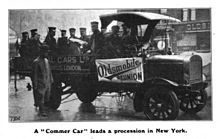Dodge is an American brand of automobiles and a division of Stellantis North America, based in Auburn Hills, Michigan. Dodge vehicles have historically included performance cars, and for much of its existence Dodge was Chrysler's mid-priced brand above Plymouth.

The Rootes Group or Rootes Motors Limited was a British automobile manufacturer and, separately, a major motor distributors and dealers business. Run from London's West End, the manufacturer was based in the Midlands and the distribution and dealers business in the south of England. In the decade beginning 1928 the Rootes brothers, William and Reginald, made prosperous by their very successful distribution and servicing business, were keen to enter manufacturing for closer control of the products they were selling. One brother has been termed the power unit, the other the steering and braking system.

The Hillman Minx was a mid-sized family car that British car maker Hillman produced from 1931 to 1970. There were many versions of the Minx over that period, as well as badge-engineered variants sold by Humber, Singer, and Sunbeam.

Chrysler Europe was the American automotive company Chrysler's operations in Europe from 1967 through 1978. It was formed from the merger of the French Simca, British Rootes and Spanish Barreiros companies. In 1978, Chrysler divested these operations to PSA Peugeot Citroën.

The Hillman Husky was a line of British passenger vehicles manufactured between 1954 and 1970 by Hillman.

The D series is a line of pickup trucks that was sold by Dodge from October 1960 to September 30, 1993. The same basic design was retained until the October 1993 introduction of a completely redesigned Ram. The D/W series shared its AD platform with the Dodge Ramcharger/Plymouth Trail Duster twins. 4×2 models were designated D, while 4×4 models were designated W.

The Vulcan Motor and Engineering Company Limited, of Southport, England, made cars from 1902 until 1928 and commercial vehicles from 1914 until 1953.
Bedford Vehicles, usually shortened to just Bedford, was a brand of vehicle manufactured by Vauxhall Motors, then a subsidiary of multinational corporation General Motors. Established in April 1931, Bedford Vehicles was set up to build commercial vehicles. The company was a leading international lorry brand, with substantial export sales of light, medium, and heavy lorries throughout the world.

The Dodge 50 Series, later known as the Renault 50 Series, were light commercial vehicles produced in the UK by Chrysler Europe and later Renault Véhicules Industriels between 1979 and 1993 as a replacement for the earlier Dodge Walk-Thru stepvan and smaller Dodge Spacevan cab-over van. The Dodge 50 series utilized the same cab as the American Dodge B series vans, however in a modified state catered for European regulations. The chassis however was British-deisgned and had no parts shared with the American van, being significantly bigger.

Karrier was a British marque of motorised municipal appliances and light commercial vehicles and trolley buses manufactured at Karrier Works, Huddersfield, West Yorkshire, by Clayton and Co., Huddersfield, Limited. They began making Karrier motor vehicles in 1908 in Queen Street South, Huddersfield. In 1920, H.F. Clayton sold Clayton and Co's Huddersfield business into public listed company Karrier Motors while keeping their Penistone operation separate. Mechanical and electrical engineers Clayton & Co Penistone, remain active in 2020 as Clayton Penistone Group.

The Dodge 100 "Commando" models also known as Dodge Commando 100 Series are 7.5–28 short tons (6.8–25.4 t) trucks built by Dodge in England, primarily in the 1970s and 1980s. A previous Dodge 100, known informally as the "parrot-nose" or "Kew Dodge", was produced in the 1950s at a factory in Kew, London.

The Ford Thames 400E is a commercial vehicle that was made by Ford UK and introduced in 1957. Production of the range continued until September 1965, by which time a total of 187,000 had been built. Publicity for the model included hiring the Cy Laurie band to make the promotional film short 'Band Wagon', in 1958, preserved in the 'Ford Film and Video Collection' at the National Motor Museum, Beaulieu

The Humber Hawk is a four-cylinder automobile manufactured from 1945 to 1967 by British-based Humber Limited.
The Commer TS3 was a diesel engine fitted in Commer trucks built by the Rootes Group in the 1950s and 1960s. It was the first diesel engine used by the company.

The Dodge LCF was a series of medium- and heavy-duty trucks built by Dodge from 1960 until 1976. They replaced the Dodge COE range of cabover trucks built in the 1950s. The 500 through 700 series were medium duty only, while 800 through 1000 series were reserved for heavy-duty versions.

Mack Trucks has been selling heavy duty trucks and buses to the United States military since 1911. Virtually every model has been used. The majority have been commercial models designed and built by Mack with their own components, but they have also designed and built military specification tactical trucks. The military vehicles are rated by payload measured in tons.

The Commer FC was a forward control commercial vehicle produced by Commer from 1960 to 1976. During its lifespan, it was developed into the Commer PB in 1967, and the Commer SpaceVan in 1974. After the Rootes Group, which owned Commer, was purchased by Chrysler, the SpaceVan was also sold under the Dodge, DeSoto and Fargo marques. From 1976 onwards, the van was only sold as the Dodge SpaceVan, and it remained in production until 1983.

In 1939, Dodge presented a completely redesigned line of trucks. Formally the T series for 1939, V series for 1940, and the W series from 1941 through 1947, the trucks became mostly known as the Dodge Job-Rated trucks.

Thames was a commercial vehicle brand produced by Ford of Britain.
The Wade supercharger was a Roots-type supercharger designed for internal combustion engines and produced from 1947 by the newly formed Wade Engineering Ltd, of Gatwick Airport, Horley, Surrey. The name 'WADE' comes from Winslett And DEnsham, after Bryan Winslett and Costin Densham.



































